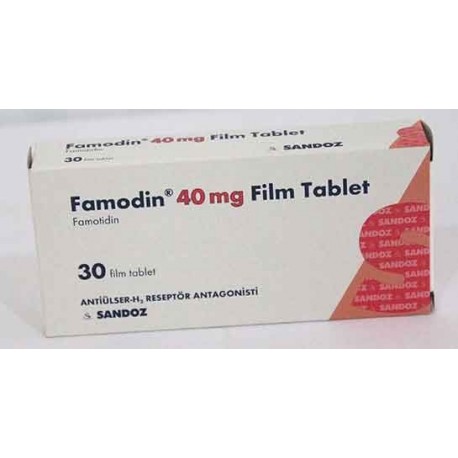 View larger
View larger Famodin (Pepcid, Famotidine) Tablets
New product
BUY MORE PAY LESS
| Quantity | Discount | |
|---|---|---|
| 2 | 5% | |
| 3 | 10% | |
| 4 | 15% | |
| 5 | 20% |
Volume discounts
| Quantity | Discount | You Save |
|---|---|---|
| 2 | 5% | Up to $3.20 |
| 3 | 10% | Up to $9.60 |
| 4 | 15% | Up to $19.20 |
| 5 | 20% | Up to $32.00 |
More info
Active ingredient
Famotidine 40 mg
Excipients
Microcrystalline cellulose PH-101, pregelatinized corn starch, talc, magnesium stearate, titanium dioxide, hypromellose 3 cp, hypromellose 5 cp, hypromellose 15 cp, red iron oxide, yellow iron oxide, black iron oxide
2. What is PEPCID and what is it used for?
PEPCID contains famotidine as an active ingredient. Famotidine belongs to the class of drugs called FL receptor antagonists. It acts by reducing the amount of acid produced by the stomach.
Packaged in blisters containing PEPCID 30 film tablets.
PEPCID can be used in the following situations:
To treat and prevent recurrence of ulcers in your stomach (gastric) and first part of your small intestine (duodenal),
To treat conditions in which the stomach produces too much acid and the acid passes into the esophagus causing burning (such as gastroesophageal reflux) and to prevent recurrence
3. How to use PEPCID?
Instructions for appropriate use and dose / frequency of administration
Use PEPCID as recommended by your doctor.
Unless otherwise recommended by the doctor, the following dosage form is administered to adult patients:
Duodenal ulcer and gastric ulcer:
The recommended dose is 40 mg, taken once before going to bed. Treatment should be continued for 4-8 weeks. The duration may vary depending on the response to treatment. The continuation dose is 20 mg taken before going to bed at night to prevent recurrence of the ulcer.
Gastroesophageal reflux (GERD):
For the treatment of mild symptoms: It can be used at a dose of 20 mg in the morning and 20 mg in the evening for 6-12 weeks.
For the treatment of more severe symptoms: It can be used at a dose of 40 mg in the morning and 40 mg in the evening for 6-12 weeks.
- In pathological hypersecretion conditions such as Zollinger-Ellison Syndrome and multiple endocrine adenomas):
Dosage depends on the patient. The recommended starting dose is 20 mg every 6 hours. Some patients may need to use higher doses.
Application route and method
PEPCID is for oral use only. Swallow the tablets with a glass of water without chewing or crushing them.
Different age groups
Use in children
It is not recommended for use in children and under 18 years of age.
Use in the elderly
Dose adjustment is not required for elderly patients.
Special use cases
If you have kidney failure, your doctor will adjust the dose of your medication specifically for you. Your doctor can reduce the PEPCID dose in half.
If you have an impression that the effect of PEPCID is too strong or too weak, talk to your doctor or pharmacist.
4. What are the possible side effects?
Like all medicines, people who are sensitive to the substances contained in PEPCID may have side effects.
If any of the following occur, stop using PEPCID and inform your doctor immediately:
Sudden high fever, severe sore throat or mouth sores, pale skin, fatigue, difficulty breathing, dark urine, infections more often, tingling and numbness in the hands and feet due to a decrease in the number of white blood cells and red blood cells, a type of white blood cells (agranulocytosis) significant decrease in the number, decrease in all blood cells
Severe shortness of breath or sudden worsening of breathing, cough or fever (sometimes fatal) indicative of possible inflammation of the lungs
Severe skin reactions such as blisters that look like scalding on the skin (toxic epidermal necrolysis, which can sometimes be fatal), rash on the lips, eyes and mouth, redness, blistering, peeling of the skin and fever (Stevens-Johnson Syndrome)
Severe allergic condition (anaphylaxis) manifested by symptoms such as rash, itching or hives on the skin, swelling of the face, lips, tongue or other parts of the body, shortness of breath, wheezing or difficulty in breathing, breathing difficulties, joint pain
Common (less than one in 10 patients, but more than one in 100 patients)
Headache, dizziness
Constipation, diarrhea
Uncommon (less than one in 100 patients, but more than one in 1000 patients)
Loss of appetite
Nausea, vomiting, abdominal pain or bloating, gas
Dry mouth, taste perversion
Rash, itching, urticaria (hives)
Fatigue
Rare (may be seen less than one in 1,000 patients)
Rare cases of gynecomastia (enlarged breasts in men) have been reported, but the frequency was not higher than placebo in controlled clinical studies.
Very rare (may be seen less than one in 10,000 patients)
Differences from normal blood cell counts such as agranulocytosis, pancytopenia, leukopenia, thrombocytopenia, neutropenia
Hypersensitivity reactions (anaphylaxis, angioneurotic edema, bronchospasm)
Reversible mental disorders, including depression, irritability, restlessness, impaired ability to adapt to the environment (disorientation), confusion, hallucination (seeing, hearing or feeling things that are not there). These complaints usually disappear with the discontinuation of the drug.

